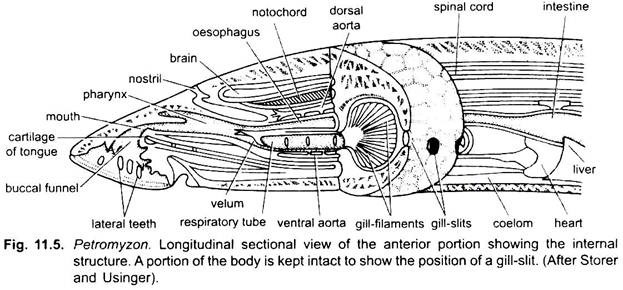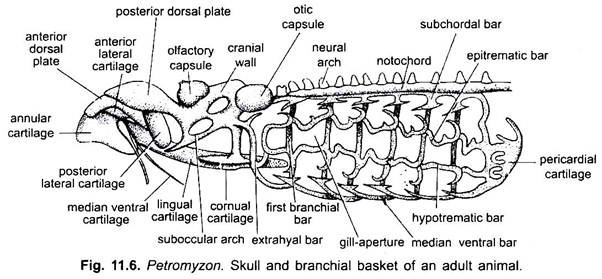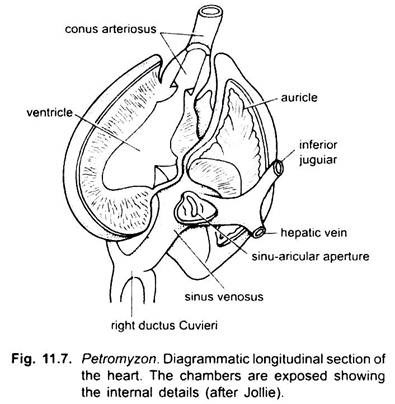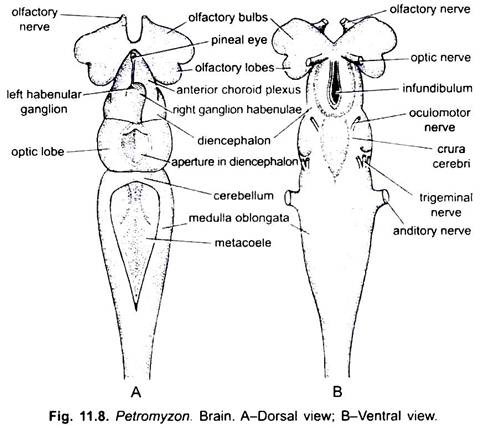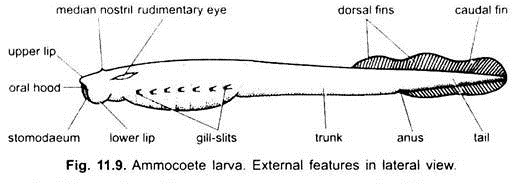In this article we will discuss about the anatomy of lamprey with the help of suitable diagrams.
Body Wall:
The skin is soft, slimy and consists of many layers of cells. The epidermis is composed mostly of unicellular gland cells that produce slimy secretion and its outermost cells border show cuticular striations. The dermis is composed of bundles of collagenous and elastic fibres.
These fibres are arranged in circular fashion. Between the dermis and body wall musculature, there lies a subcutaneous layer containing pigment cells, blood vessels and fatty tissue. The pigment cells or chromatophores have the power of migration for changing the skin colour. They are also present in the dermis.
Muscular System:
The muscles of trunk and tail are arranged in E-shaped myotomes, separated by myocommas. The myotomes are W or E-shaped muscle blocks and the muscle fibres composing the myotomes run longitudinally. The myotomes of one side alternate with those of the other.
ADVERTISEMENTS:
The muscle fibres are striated. Contraction of muscles of one side bends the body to that side. These muscles are helpful in swimming of the fish. Radial muscles operate the buccal funnel and the tongue is moved by stout retractor and smaller protractor muscles.
Skeleton:
It includes the notochord and cartilaginous endoskeleton. The axial skeleton comprises a lowly developed skull, persistent notochord and collection of cartilages. The notochord is composed of large vacuolated notochordal cells enveloped by a thick fibrous notochordal sheath.
This is further surrounded by another connective tissue layer which covers the spinal cord and remains connected with the myocommas. Connective tissue layer contains scattered thickening of cartilaginous elements. Besides notochord, body skeleton is formed of cartilage. The cartilage is composed of large cells embedded in a matrix of chondrin.
ADVERTISEMENTS:
(i) Numerous slender cartilaginous rods extend dorsally and ventrally to support the median fins.
(ii) The skull is very peculiar and primitive in structure. Its floor is formed by a basal plate made by the union of parachordals and trabeculae surrounding posteriorly the anterior end of the notochord. Attached with the basal plate there are pieces which form an incomplete cartilaginous box enclosing the brain and the special sense organs.
Immediately anterior to the notochord is a large aperture, the basi-cranial fontanelle due to the non-union of the posterior ends of the trabeculae. Through this aperture passes the naso-hypophysial sac. The side walls of the cranium are strong but the roof is exclusively composed of tough membranous fibro-cartilage excepting a narrow transverse bar. Two compact auditory capsules are united with the posterior end of the basal plate.
The olfactory capsule is an unpaired concave-convex plate which supports the posterior wall of the olfactory sac and is pierced by the paired apertures for the olfactory nerves. This capsule is united with the cranium by fibrous tissue.
ADVERTISEMENTS:
On each side of the basal plate, there lies the subocular arch to support the eye. A slender styloid process hangs from the subocular plate. Each styloid process is connected with a small cornual cartilage. The cranium is attached with the skeleton that supports the gills and buccal funnel.
(iii) The branchial basket is composed of nine irregularly curved vertical bars of cartilage on each side. The first vertical bar is placed almost immediately posterior to the styloid cartilage and is homologous with the extra-hyal cartilage of the elasmobranchs. The second lies immediately in front of the first gill-cleft, and the remaining seven just behind the seven gill-clefts. These bars are united together by four longitudinal rods.
(iv) The posterior part of the branchial basket is extended to form a cup-like pericardial cartilage to accommodate the heart. The whole branchial basket lies external to the gill pouches and branchial arteries, not like typical visceral arches, in the walls of the pharynx.
(v) The buccal funnel is supported by a ring-like annular cartilage.
(vi) An elongated lingual cartilage supports the tongue.
Digestive System:
The mouth is situated just above the tongue at the base of the buccal funnel. The opening and closing of the mouth is done by the fore-and- aft piston-like movement of the tongue. The buccal funnel is a specialised cup-like depression which acts as a sucker. Numerous teeth are present in the buccal funnel which are laminated horny cones. Beneath them lie mesodermal papillae (covered with ectoderm). The teeth that are borne on the tongue are elongated and sharply pointed.
The teeth are capable of being replaced, if lost. Special set of muscles operate the buccal funnel and tongue apparatus. Lampreys can attach with the body of other fishes by producing a vacuum cup inside the buccal funnel. The vacuum cup is produced inside the oral cavity by the pulling on the tongue backwards by the contraction of the cardio-apicalis muscle. The release of sucker is effected by the contraction of an annular muscle running along the margin of the buccal funnel.
The mouth leads into a buccal cavity formed from the stomodaeum of the embryo, it communicates behind with two tubes a dorsal oesophagus and the ventral respiratory tube or pharynx having linearly arranged 7 gill-slits on either side.
ADVERTISEMENTS:
Guarding the entrance of the respiratory tube is a curtain-like fold, the velum with velar tentacles. The velar apparatus keeps the digestive part completely separated from the respiratory tube when the animal feeds. The oesophagus leads directly into a straight intestine by a vulvular aperture.
True stomach is absent in lampreys. The posterior end of the intestine is widened to form the rectum which opens through anus in the cloaca. The lumen of the intestine is crescentic due to the presence of a spiral longitudinal fold, the typhlosole. The typhlosole takes a slightly spiral course along the intestine and is, hence, known as spiral valve.
The digestive glands are well-developed in lampreys. The liver is a bilobed organ and surrounds the anterior part of intestine. Gall-bladder and bile-duct occur in the larval stage, but are absent in the adult. There is no pancreas as such.
In both larval and adult lampreys, however, there occur in the gut epithelium aggregations of seemingly secretory cells of two different kinds- one kind (zymogen cells) produce a proteolytic enzyme, and the other cells are involved in carbohydrate metabolism. This second, probably endocrine, group has no communication with the lumen of the intestine. A pair of buccal or salivary glands opening beneath the tongue secretes an anticoagulant.
The actual mode of feeding in lampreys is not known. They are predators on the body of fishes. They attach themselves by means of powerful sucker-like buccal funnel with the body of fish. They eat their flesh by rasping with the powerful. They also inject the anticoagulant in saliva into the wound and sucks blood and body fluids of the fish, etc., (sanguivorous habit) tongue apparatus.
Respiratory System:
The respiratory organs of lamprey comprise seven pairs of gills or branchial pouches or branchial sacs between the respiratory pharynx and the body wall. The branchial pouches open directly into the respiratory tube and have no direct connection with alimentary canal.
The gill-pouches have numerous vascular gill-lamellae developed on their inner surfaces and are separated from one another by wide membranous interbranchial septa. Each gill-pouch opens independently to the exterior by an external gill-slit and m the respiratory pharynx by an internal gill-slit.
The water enters into the respiratory pharynx through the 7 pairs of gill-pouches and passes out through the same route. But in larval stage, water current enters through mouth and goes out through the gill-slits.
The elastic branchial basket is compressed by the contraction of the muscles to throw the water like jets through the gill-openings, while during inspiration the branchial basket expands. The gaseous exchange takes place inside the gill-pouches bearing vascular gill-filaments or lamellae.
Circulatory System:
In lamprey the circulatory system is well developed and similar to Amphioxus. The heart is an S-shaped structure situated behind the last pair of gill-pouches. It is enclosed in a thick-walled pericardium supported by a cartilaginous plate. The heart consists of three chambers- a sinus venosus, an auricle and a ventricle.
The sinus venosus is a thin-walled chamber and leads into a thin-walled auricle lying above the sinus venosus. The auricle opens into the thick-walled ventricle. There is no conus arteriosus. The ventricle leads into the ventral aorta whose proximal end presents a slight dilation or bulbous anteriosus.
The ventral aorta gives off 7 pairs of efferent branchial arteries to 7 pairs of gills. Oxygenation of blood occurs here. From gills blood enters into 7 pairs of efferent branchial arteries, which unite to form a median dorsal aorta distributing the blood to the various parts of the body.
There is no renal portal system but a hepatic portal vein is present. The blood of lamprey is red in colour due to the presence of haemoglobin. It contains both red blood corpuscles and white blood cells. The blood forming tissue is present in the kidneys and the spinal cord. Lymphatic system is also present.
Nervous System:
The nervous system of lamprey is quite well-developed. The brain exhibits the typical pattern that is found throughout the vertebrate series. Some of the structures that are well-developed in the higher forms occur in a relatively primitive condition.
The brain is divisible into three primary parts, viz., forebrain or prosencephalon, midbrain or mesencephalon and hindbrain or rhombencephalon. The forebrain includes large paired olfactory lobes followed by a pair of small cerebral hemispheres attached to the diencephalon.
A broad infundibulum lies attached beneath the diencephalon and it dorsally gives off a pineal or median eye. The midbrain possesses a pair of large optic lobes rather dorsally placed. The hindbrain is differentiated into a dorsal small transverse band, the cerebellum and a much larger dorsal medulla oblongata. Between the optic lobes and the medulla oblongata extends the choroid plexus. The ventricles within the brain are four as in other vertebrates. The cranial nerves are ten pairs.
The spinal cord is band-like structure which is dorso-ventrally flattened. It is of transparent grey colour. The spinal nerves are like those of Amphioxus in that the dorsal and ventral roots do not join. The sympathetic nervous system is poorly developed.
Sense Organs:
The organs of special sense are well-developed. The paired eyes are primitive and having no suspensory ligament and ciliary apparatus. They are formed, like the pineal eyes, by evaginations of the wall of the diencephalon. Accommodation is affected by a process found in no other vertebrates.
Cornea consists of two distinct layers, separated by a gelatinous substance Iris is present around pupil which does not change in diameter under different illuminations. Median eye or pineal organ is better developed. It contains a pigmented retina with sensory cells and a flattened imperfect lens. It is photosensitive. The membranous labyrinth has only two semicircular canals.
The single external nostril leads by a short passage into a rounded olfactory sac lined by olfactory mucous membrane. It gives off a large naso-hypophyseal sac which ends blindly below the anterior end of notochord. The lateral line sense organs are relatively simple and are exposed to the surrounding water and innervated by cranial nerves.
Excretory System:
In lamprey, the adult functional kidney is of mesonephric type. The kidney develops from the nephrogenous tissue (nephrotome). Each kidney is long, strap-shaped body developed from the mesonephros of the embryo.
The mesonephric tubules become greatly elongated winding tubule and the anterior end of each tubule bears a double-walled Bowmann’s capsule containing glomerulus. Each kidney is attached along one edge to the dorsal wall of the body cavity by part of the peritoneum.
Along the other (free) edge runs the mesonephric duct which opens posteriorly into a small urinogenital sinus placed just behind the rectum. This opens by a urinogenital papilla into a pit, the cloaca in which the alimentary canal also ends.
The side walls of the sinus are pierced by a pair of genital pores which place its cavity in communication with the coelom. Kidneys contain lymphoid tissue where blood cells may be formed. This tissue is also phagocytic-destroys old blood cells.
Reproductive System:
The sexes are separate in the adult. The gonad is a large unpaired occupying almost the whole of the body cavity and lack reproductive duct. The testis consists of many follicles containing male gametes which are liberated into the body cavity.
The ovary is composed of eggs which are covered by a layer of follicular epithelium. The eggs also rupture in the body cavity. From the body cavity both the eggs and sperms escape by way of abdominal pores present in the lateral walls of urinogenital sinus and escape outside the body through urinogenital opening. Fertilisation is, thus, external, i.e., occurs in water.
Life History:
Lampreys become sexually nature in spring or early summer and migrate into freshwater streams or rivers for breading. On return to the rivers they stop feeding and start building nests of small stones in river beds. The males remove pebbles from river beds by their buccal funnel and make a small pit.
In mating, the male holds the female near her head by its buccal funnel, then the two intertwine their bodies. Eggs are squeezed out through the cloaca into the nest and sperms are deposited on them. Fertilisation is, thus, external. The eggs and sperms are not laid at once; mating is repeated several times, after which the animals are exhausted and soon die.
Fertilised eggs are covered up with mud or sand so that they are not carried away by the current. The eggs are small, being 1 mm in diameter, they are telolecithal but cleavage is holoblastic and unequal. Gastrulation is by invagivation. In 3 to 4 weeks the young hatches from the egg, it is called an ammocoete larva which is at first transparent and about 1 cm long.
The larva lives in U-shaped tunnels of mud where it feeds on organic ooze at night. It emerged from its tunnel at night only to change its feeding ground. It swims with its head downwards and then buries itself again. The larval period is of long duration, it is 3 to 4 years, but in some lampreys it may be 7 years. During this period the ammocoete larva becomes opaque and grows to 170 mm in length.
Ammocoete Larva:
Ammocoete larva has an eel-like body, but it differs from the adult in several respects. It has a single continuous median dorsal fin. There is no buccal funnel, the mouth is surrounded by a semicircular upper lip of oral hood like that of Amphioxus. Below the mouth is a short transverse lower lip, there are no teeth.
The paired eyes are covered by muscles and skin. Branched buccal tentacles lie at the entrance to the alimentary canal. Behind these tentacles is a velum made of a pair of cup-shaped structures attached to anterior wall of pharynx. The pharynx has seven pairs of gill-pouches. The pharynx is continued posteriorly into the oesophagus.
On the tail are photoreceptors which ensure that the larva lies completely buried. Below the pharynx is a short sac-like endostyle having glandular cells. It is different from that of an Amphioxus in not being an open groove. In the floor of the pharynx, i.e., on the roof of endostyle, however, is a ciliated groove. Mucus from the endostyle goes to the groove in the pharynx, and then to a pair of peripharyngeal grooves behind the velum.
The velum maintains a stream of water into the pharynx, in this it is helped by muscular movements of the pharynx. Food particles consisting of unicellular algae and bacteria come through the mouth with the current of water and are entangled in mucus.
In the pharynx the food-laden mucus forms a cord which is carried into the oesophagus. Cilia in the oesophagus now propel the food into the gut. Thus, feeding in the ammocoete larva is by muscular movements of velum and pharynx, whereas in Amphioxus it is brought about by ciliary action, this is a forward step in evolution. It enables a quicker and larger intake of food.
Metamorphosis:
After a prolonged larval period (i.e., 3 to 7 years) metamorphosis occurs.
(i) The buccal region elongates so that the oral hood becomes the buccal funnel with horny teeth, tongue, and a round mouth.
(ii) The endostyle becomes modified to form a thyroid gland which contains iodine.
(iii) The velum disappears leaving a rudiment from which skeletal rods develop to form a filter guarding the pharynx.
(iv) The oesophagus separates from the pharynx and comes to lie dorsal to it.
(v) Gall-bladder and bile duct disappear.
(vi) Gills develop into pouches and open into the pharynx.
(vii) Paired eyes develop completely and move to the surface,
(viii) The nasohypophysial sac enlarges posteriorly
(ix) The continuous dorsal fin breaks into two dorsal and a single caudal fin.
(x) Pericardial cavity becomes separate from the coelom.
The colour of the skin changes from light brown to blackish. Metamorphosis is completed within a few weeks. The young lamprey migrates downstream from river to the open sea where it remains for 3 or 4 years and becomes carnivorous adult. But the gonads ripen only when it returns to the rivers for spawning.
The ammocoete larva is of special interest because it shows striking similarities with Amphioxus, and because it is a very primitive and generalised vertebrate, it may be regarded as a connecting link between Amphioxus and cyclostomes.
